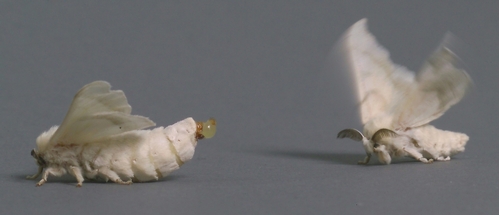- Author: Kathy Keatley Garvey
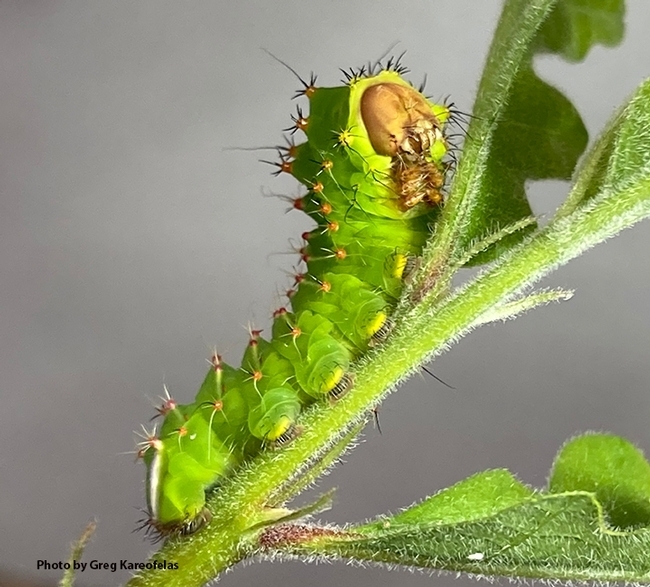
Those attending the Bohart Museum of Entomology's recent Moth Night learned all about silkworms, moths, cocoons and textiles at a display staffed by Michael "Mike" Pitcairn, a retired senior environmental scientist/supervisor with the California Department of Food and Agriculture.
Mulberry silk production originated in China at least 5000 years ago. Folklore indicates that the wife of a Chinese emperor watched a cocoon fall from a mulberry tree into her teacup. She reportedly watched the cocoon unravel, revealing a long delicate thread. She collected thousands of the threads and made a robe for the emperor.
Biology Professor Richard Peigler of University of the Incarnate Word, San Antonio, donated the items to the Bohart Museum in 2020, said UC Davis Distinguished Professor Emerita Lynn Kimsey, former director of the Bohart. "What's cool about it is," she said, "is that the silk pieces were made from silk produced by multiple silk moth species, not just the one we think of commercially."
The mulberry moth is the primary producer of silk. Tussah is the most well known of the wild silks.
Peigler has worked extensively with wild silk moths, studying their phylogeny, taxonomy and biology. His donations comprise the Wild Silks collection at the McGuire Center for Lepidoptera and Biodiversity, Florida Museum of Natural History, University of Florida.
"Wild silk is not nearly as luxurious as domestic silk found in today's clothing industry," the McGuire Center website relates. "This is raw, rough, and textured silk which feels almost paper-like to the human touch. This silk is harvested from the cocoons of various silk moths that encounter little to no human interaction. The practice of producing silk – termed sericulture, stretches back 5 millennia, and astonishingly, is a craft performed to this very day."
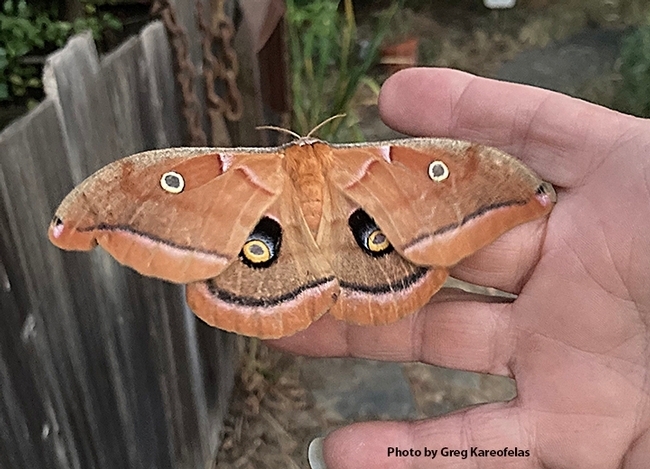
They included a woman's chaddar (head covering and shawl) and tablecloths.
Eri Silk (Samia ricini). Displayed was a woman's chaddar of 100 percent eri silk (Samia ricini), handwoven in Assam, India, and of naturally colored yarn. The brocade was done in traditional Assamese motifs. Women in rural villages in Northeast India wear these traditional shawls in winter. Peigler bought the chaddar for $47 from a seller in India in 2019.
Tussah Silk (Antheraea pernyi). Displayed was an antique tablecloth of tussah silk, handwoven in China in the 1920s or 1930s. The tablecloth, hand-reeled and in the natural beige color, is hand-embroidered with mulberry silk (Bombx mori). China has exported thousands of tablecloths and handkerchiefs made of tussah silk (called "pongee" or "Shantng silk") to the United States and the United Kingdom. Peigler purchased this tablecloth in April 2019 from an internet seller in Mount Dora, Fla., for $35.
Also of interest was a sample of tussah silk fabric in a pattern called "Honeycomb," mimicking the hexagonal cells in a bee colony. "The yarns were machine spun and the fabric was machine woven," said Peigler, who purchased the fabric from Oriental Silk Import Co. in Los Angeles for $32.95 per yard. There are several species of tussah silk moths (family Saturniidae) in China, India, Japan, Africa and North America.
Mulberry Silk (Bombx mori). Displayed was a tablecloth created in the early 1900s in China. "It was spun, woven and embroidered by hand," Peigler related.
The Bohart Museum, founded in 1946, is located in Room 1124 of the Academic Surge Building, 455 Crocker Lane, UC Davis campus. It also includes a live petting zoo and an insect-themed gift shop. Director of the museum is Professor Jason Bond, the Evert and Marion Schlinger Endowed Chair of UC Davis Department of Entomology and Nematology, and associate dean, Agricultural Sciences, UC Davis College of Agricultural and Environmental Sciences.
The Bohart Museum is open to walk-in visitors on Tuesdays from 9 a.m. to noon and from 1 to 4:30 p.m. through Aug. 27. It will be closed to the public Sept. 1-22.
The next open house is set for 1 to 4 p.m., Saturday, Sept. 28. The theme is "Museum ABC's: Arthropods, Bohart and Collecting." All open houses are free and family friendly. Parking is also free. For more information, contact bmuseum@ucdavis.edu or access the website at https://bohart.ucdavis.edu.
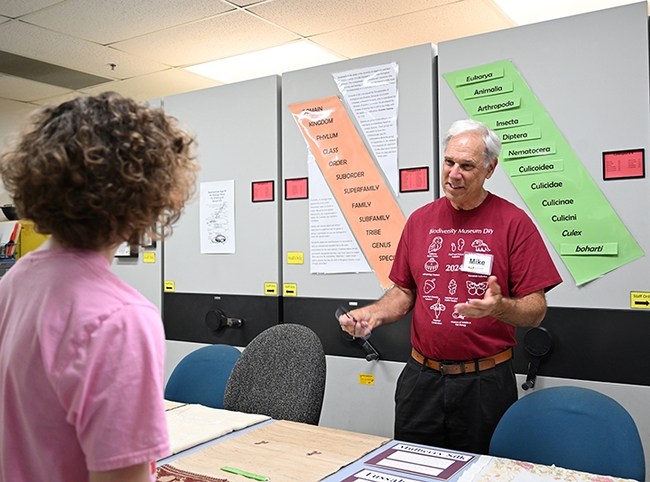
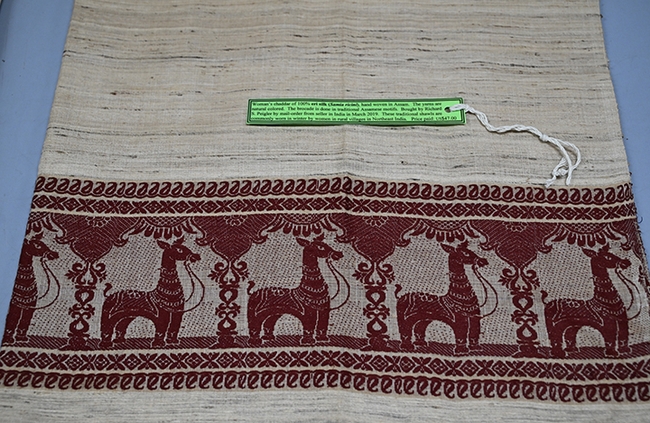
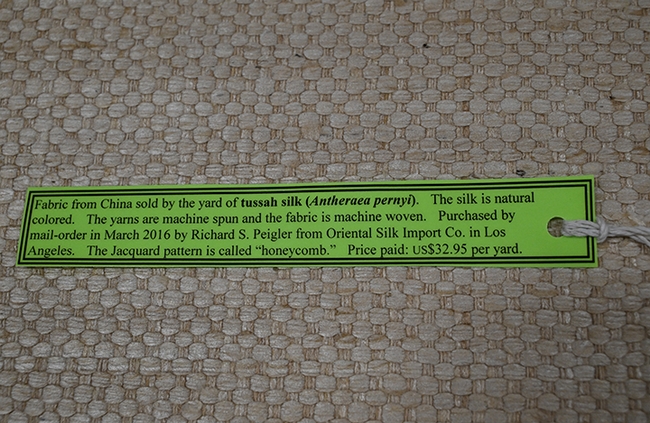
- Author: Kathy Keatley Garvey
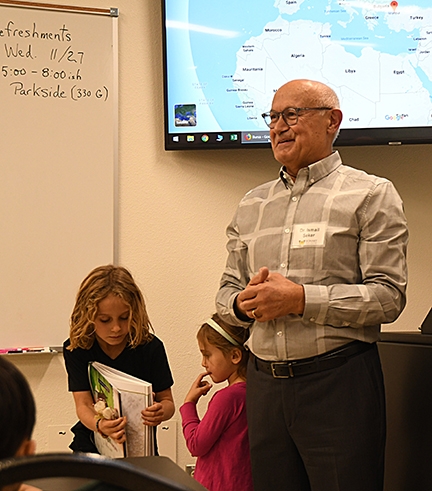
Silkworm moth expert İsmail Şeker, a Turkish medical doctor and author of a book showcasing his hobby, displayed the eggs, larvae, pupae, adults, as well as silk fabric, and fielded questions from the audience.
Seker showed his newly produced 13-minute video detailing the history of the silkworm moth and its life cycle. The crowd marveled at his macro photography and exquisite videography. Assisting him at the presentation were his grandson, Emre, 7, and granddaughter, Ruya, 4. Their father, Erkin Seker, is an associate professor in the UC Davis Department of Electrical and Computer Engineering.
The silkmoth, Bombyx mori, domesticated in China more than 5,000 years ago, belongs to the family Bombycidae, The life cycle: egg, larva, pupa and adult. Their food: mulberry leaves.
The caterpillars are celebrated for spinning silk; each cocoon is comprised of a single strand of raw silk from 1000 to 3000 feet long. It takes about 2000 to 3000 cocoons to make a pound of silk. Worldwide, silkworms produce some 70 million pounds of raw silk, requiring nearly 10 billion cocoons.
The adults cannot fly, and neither eat nor drink. They mate, lay eggs, and the cycle continues.
Seker donated cocoons for the Bohart Museum's family craft activity and watched visitors gleefully turn the cocoons into decorated finger puppets.
Among the visitors: 40 students from the Samuel Jackson Middle School and the James Rutter Middle School, Elk Grove Unified School District, in a program offering special educational opportunities and mentoring. The youths wore t-shirts lettered with "The Power of Us" on the front, and "Resilient, Authentic, Passionate" on the back. Academic mentor Keishawn Turner said the group toured the campus, had lunch, and ended the day by attending a UC Davis football game.
(More photos of the open house pending in the next Bug Squad)
The Bohart Museum is located in Room 1124 of the Academic Surge Building on Crocker Lane. It houses a global collection of nearly eight million specimens. It is also the home of the seventh largest insect collection in North America, and the California Insect Survey, a storehouse of the insect biodiversity. The Bohart Museum maintains a live "petting zoo," featuring Madagascar hissing cockroaches, walking sticks or stick insects, tarantulas, and praying mantids. The museum's gift shop, open year around, includes T-shirts, sweatshirts, books, jewelry, posters, insect-collecting equipment and insect-themed candy.
Director of the museum is Lynn Kimsey, professor of entomology at UC Davis. The staff includes Steve Heydon, senior museum scientist; Tabatha Yang, education and outreach coordinator; and Jeff Smith, who curates the Lepidoptera (butterflies and moths) section.
More information on the Bohart Museum is available on the website at http://bohart.ucdavis.edu or by contacting (530) 752-0493 or bmuseum@ucdavis.edu.
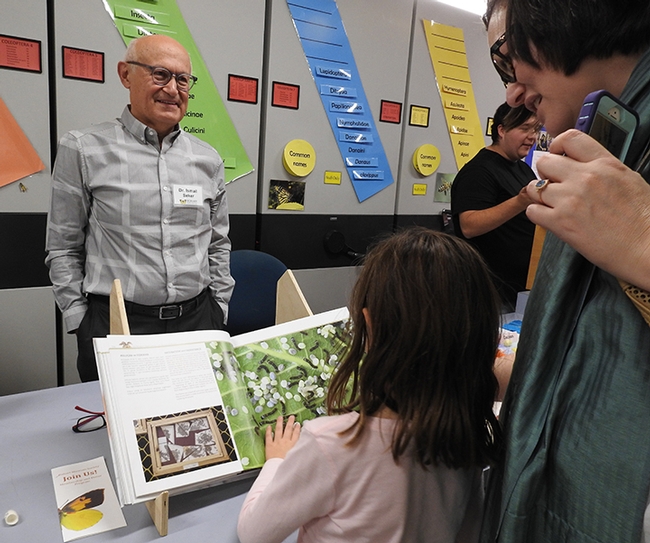
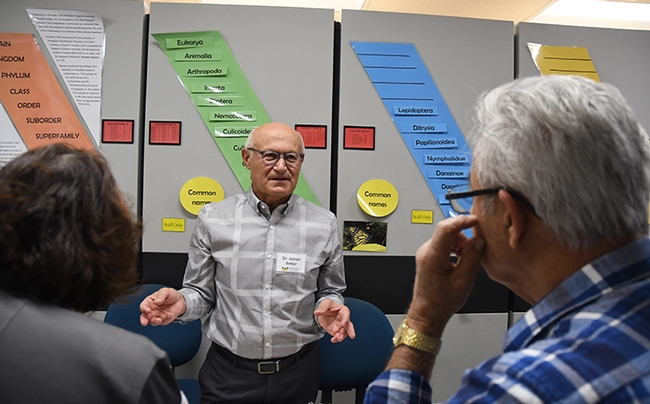
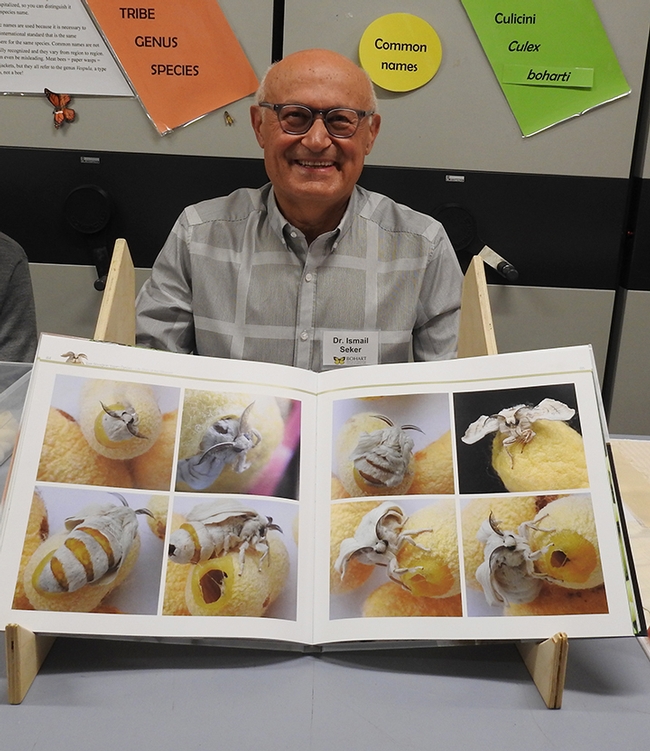
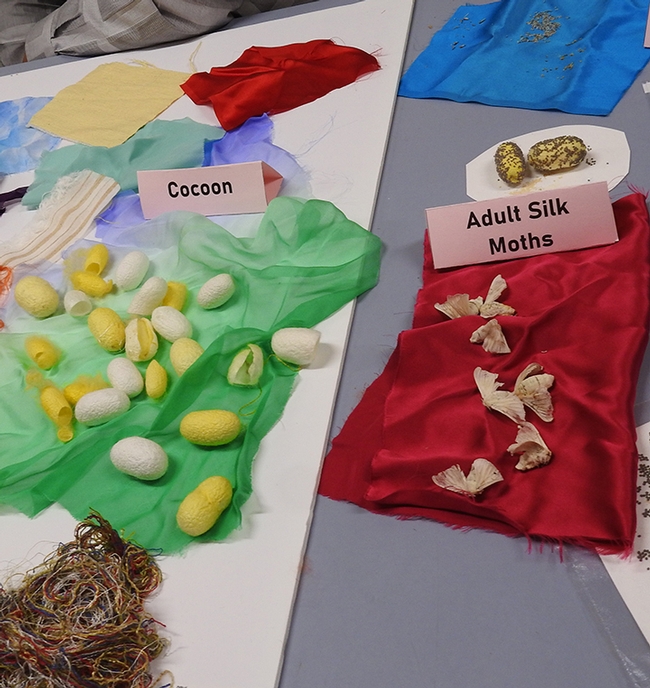
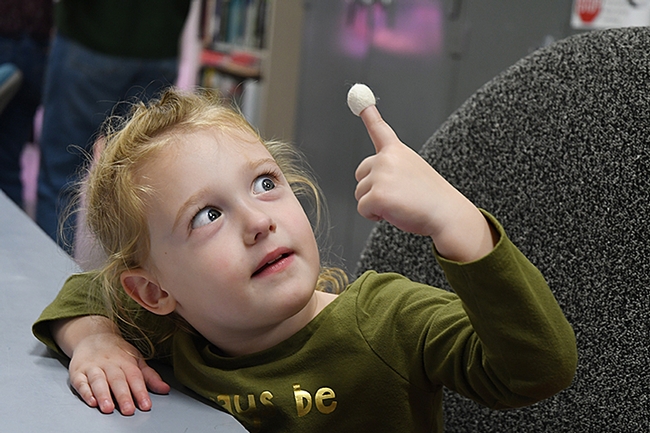
- Author: Kathy Keatley Garvey
The female silkworm moth releases a sex pheromone, bombykol, that's very enticing to the male. He can detect it from miles away.
Now researchers in the UC Davis Department of Entomology have discovered that the fruit fly has a native odorant receptor that detects the silkworm moth’s sex pheromone, and that it’s “amazingly more sensitive” than the moth’s odorant receptor.
Their work could open research doors for insect-inspired biosensors.
Walter Leal, professor of entomology, and postdoctoral scholar Zain Syed know the olfactory systems of silkworm moths (Bombyx mori) and fruit flies (Drosophilia melanogaster) well.
In a serendipitous discovery, the chemical ecologists found that the fruit fly’s odor detector not only detects bombykol, but responds to bombykol with high sensitivity. Their groundbreaking research, Bombykol Receptors in the Silkworm Moth and the Fruit Fly, was published May 3 in the Proceedings of the National Academy of Science (PNAS).Their research follows on the heels of another study they published in PNAS in 2006 with the Deborah Kimbrell genetics lab in the UC Davis College of Biological Sciences. Bottom line: they found that genetically engineered fruit flies responded to the silkworm moth scent of a female.
Now Leal and Syed have identified the odorant receptor in the male fruit fly that detects the sex pheromone.
Ecologist and evolutionary biologist Fred Gould of North Carolina State University, not affiliated with the research, says the work of the UC Davis researchers "provides important guidance and tools for other researchers who want to explore the pheromone communication systems of other species, or who want to further dissect the mechanisms within the specialized hairs of silkworms that enable this high sensitivity.”What we have here with the silkworm moths and fruit flies is definitely not a "failure to communicate."


